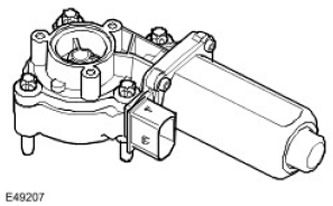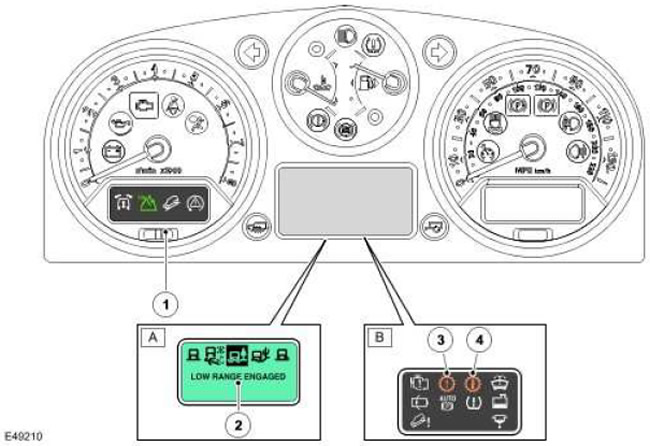- CAN bus messages
- Key interlock solenoid signal
- Signal for selected range LED
- Transfer case motor signal
- Signal for solenoid valve
CAN bus messages
The transfer case control module sends messages about the status of the transfer case to other control modules on the network via the CAN bus. The main data transmitted by the transfer case control module are: current range, clutch torque and default mode.
Key interlock solenoid
The transfer case control module can send a signal to the key interlock solenoid. This signal blocks the key in the ignition lock cylinder, preventing it from being removed unless the automatic transmission is in the park position.
Selected Range LED

| Item name | Spare part number | Description |
| 1 | - | high range LED |
| 2 | - | Low Range LED |
The control module is responsible for turning on the 2 selected range LEDs located next to the range lever. One LED serves as a high range indicator and the other as a low range indicator.
When a range is selected, the corresponding LED will turn solid.
If the range is changed, the current range LED remains on until the new range is set.
At the beginning of the range switch (that is, subject to speed and neutral requirements) the new range LED starts flashing. The new range LED stops flashing and turns solid at the same time as the old range LED turns off.
The flashing frequency is 2 Hz at a duty cycle of 50%.
The LEDs have 2 levels of brightness: high when the vehicle lights are off and low when the lights are on. If both LEDs are flashing at 0.5 Hz, this indicates either a problem with the transfer case or that the transfer case range has not been determined and calibration may be required.
Transfer box motor

The transfer case motor provides range shifting and actuates the multi-plate clutch. The electric motor is located in the rear crankcase assembly and secured with 4 bolts.
It is a DC motor with pulse-width regulation and an integrated worm gear. The electric motor is connected to the transfer case control module using an 8-pin connector; Power is supplied to the motor via 2 large diameter wires through the motor connector. An internal encoder monitors the rotation of the motor.
The motor housing has a temperature sensor.
Electromagnet

The solenoid switches the power flow in the drive system by setting the range shift mode or the clutch control mode. When the solenoid is turned on, the solenoid stem extends and the clutch control mode is set. When the solenoid is turned off, the internal spring retracts the solenoid shaft, and the range switching mode is set.
NOTE: In order to replace the solenoid during operation, it must be energized with a scan tool.
The solenoid is connected to the transfer case control module using a 2-pin connector.
Status indication
Dashboard

| Item name | Spare part number | Description |
| A | - | Upper row instrument panel |
| B | - | Lower row instrument panel |
| 1 | - | Low Range Enable Indicator |
| 2 | - | Message center text message box (only for top row) |
| 3 | - | Control lamp of malfunction of cardan transfer |
| 4 | Gimbal overheat indicator |
Vehicles with a top-row instrument panel have one low-range indicator light. This indicator is a mountain symbol and works according to the following principle:
- Indicator on = low range
- Indicator off = high range
- LED flashing = range switching in progress / range undefined / malfunction
Vehicles with a top-row instrument panel also have a field for displaying message center text messages informing the driver of any faults in the transfer case.
The following table shows the messages that may appear on the top row instrument cluster message center display and refer to the transfer case:
| Message | Description | Sound alarm |
| 'LOW RANGE ENGAGED' (low range enabled) | After receiving a request to change the range, the transfer case is in low range | Single beep |
| 'HIGH RANGE ENGAGED' (high range enabled) | After receiving a request to change the range, the transfer case is in high range | Single beep |
| 'SPEED TOO HIGH FOR RANGE CHANGE' (speed too high for range change) | Ranging request issued when vehicle speed is too high | Single beep |
| 'SELECT NEUTRAL FOR RANGE CHANGE' (select neutral for range change) | A range request has been issued, but the lever is not in neutral | Single beep |
| 'APPLY HANDBRAKE' (PARK BRAKE in USA and Canada) (turn on the brake) | This message warns the driver that the automatic transmission cannot be park-locked because the transfer case range has not been selected. The transfer box control module has stopped communicating on the CAN bus during a range shift or in neutral, making it impossible to park the automatic transmission | Single beep per second for 3 seconds |
| 'TRANSMISSION RANGE CHANGE NOT AVAILABLE' (change of ranges in the gearbox is not possible) | A fault has been detected in the transfer case preventing range shifting. Control unit disabled due to overheating | Single beep |
| 'CENTRE DIFF OVER TEMP REDUCE SPEED' (overheated center differential, reduce speed) | The temperature of the center differential is approaching a critical value | Single beep |
| 'CENTRE DIFF FAULT - TRACTION REDUCED' (center differential malfunction - tractive effort reduced) | Violation of the work of the center differential - the differential continues to work as an open differential | Single beep |
| 'CENTRE DIFF FAULT - TRACTION REDUCED' (center differential malfunction - tractive effort reduced) | The transfer case control module has stopped transmitting data on the CAN bus, and the center differential acts as open by default | Single beep |
The transfer case control module receives gear position signals from the manual transmission gear position sensor and distributes the status data on the CAN bus. This data is displayed on the odometer display, similar to how automatic transmission models display gear information.
| Odometer display | Description |
| N | Gearbox in neutral position |
| 1 | Gearbox in first gear position |
| 2 | Gearbox in second gear position |
| 3 | Gearbox in third gear position |
| 4 | Gearbox in 4th gear position |
| 5 | Gearbox in fifth gear position |
| 6 | Gearbox in 6th gear position |
| R | Gearbox in reverse gear position (Japan only) |
| Blank display | Transmission mechanism between neutral position and transmission position |
| E | Transmission Gear Position Sensor Faulty |
On vehicles with a lower row instrument panel, a status lamp is used instead of the message center, which works according to the following principle:
- Yellow color - overheating
- Red color - malfunction, stop the car
| Indication | Description |
| OFF | Transfer case operates at normal operating temperature |
| YELLOW PILOT LIGHT ON | Transfer case temperature approaching overheating threshold |
| YELLOW PILOT LIGHT ON | A fault has been detected in the transfer case affecting the range switching function (the current range is still kept), or the operation of the center differential is broken. |
| RED PILOT LIGHT ON | A malfunction has been detected in the transfer case that prevents the transmission from parking locking due to range uncertainty, OR the center differential is malfunctioning with a non-zero locking torque |
| YELLOW PILOT LIGHT ON | The transfer case control module has stopped transmitting data on the CAN bus, and the center differential acts as open by default |
| RED PILOT LIGHT ON | The transfer box control module has stopped communicating on the CAN bus during a range shift or in neutral, making it impossible to park the automatic transmission |
Comments on this article